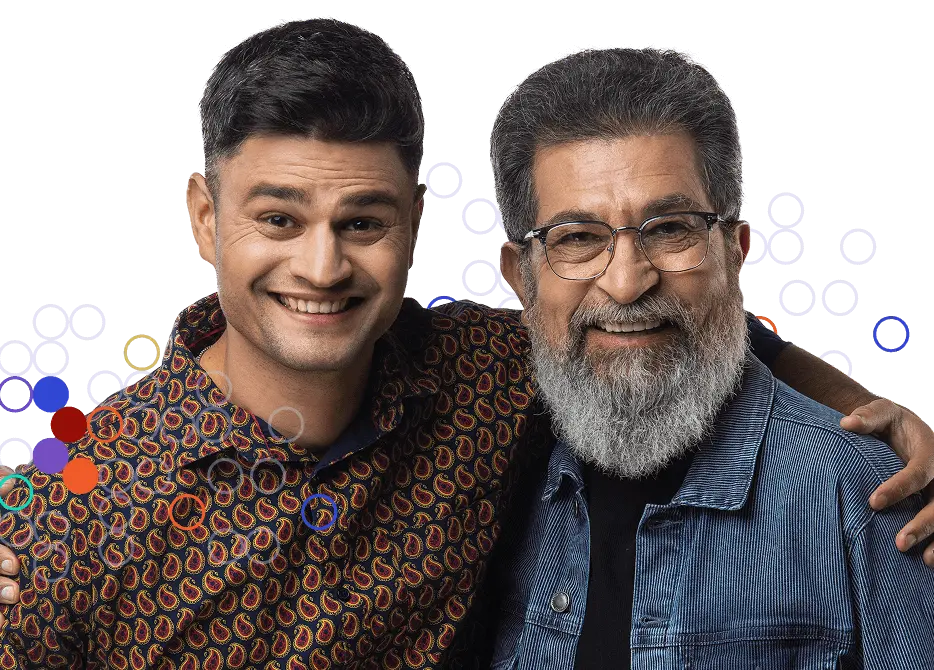The 2019 Annual Meeting of the American Association for Cancer Research in Atlanta, Georgia, is in full swing on this, the third day of the conference and the first full day of plenary talks, poster presentations, major and mini symposia, award lectures, and working groups following the morning’s opening ceremonies. Once again, advances in cancer immunotherapy and combination treatment approaches and the number of new drug approvals continue to energize the oncology community, as Norman “Ned” Sharpless, MD, outgoing director of the National Cancer Institute and incoming acting commissioner of the U.S. Food and Drug Administration alluded to in his opening ceremony remarks when he noted that, “we are no longer in the ‘bad old days’ of oncology care—a time when we had so little to offer our patients, when we had so little hope against aggressive cancers.”
Last year, during the opening plenary session at AACR18, the University of Texas at MD Anderson Cancer Center’s Padmanee Sharma, MD, PhD, declared that, “immune checkpoint therapy has joined the ranks of surgery, radiation, and chemotherapy as a pillar of cancer treatment.”
In the year since, immunotherapy has further solidified its status in mainstream cancer treatment, and through combination approaches it’s shown new signs of promise in hard-to-treat cancers, as demonstrated by the University of Pennsylvania’s Mark O’Hara, MD, who discussed results from the PRINCE pancreatic cancer trial that is being co-funded and co-organized by the Cancer Research Institute (CRI) and the Parker Institute for Cancer Immunotherapy (PICI). In the study, patients with metastatic pancreatic cancer were treated with combinations of four different drugs, including two standard-of-care chemotherapies and two immunotherapies—a PD-1 checkpoint immunotherapy and a CD40 pathway agonist. All patients received the chemotherapy and CD40-targeting treatments, while half were also treated with the PD-1 immunotherapy. Overall, of the 24 evaluable patients, 20 saw their tumors shrink.
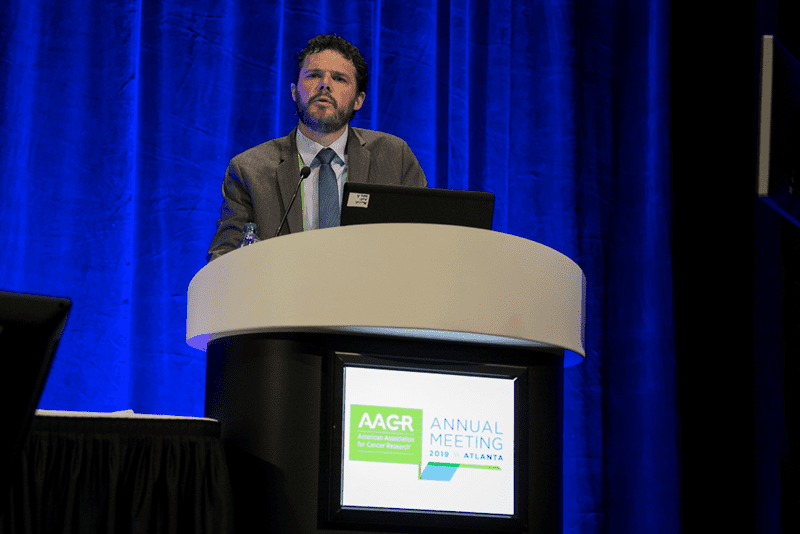
Mark O’Hara, MD, discusses results from the PRINCE pancreatic cancer trial.
“Although the results are early, we see encouraging signs that anti-CD40 immunotherapy, checkpoint inhibition, and chemotherapy in combination could be an effective new approach to treat patients with metastatic pancreatic cancer,” said study leader Robert H. Vonderheide, MD, DPhil, a member of the CRI Clinical Accelerator leadership, a PICI investigator, and the director of the Abramson Cancer Center of the University of Pennsylvania.
During the opening plenary session, E. John Wherry, PhD, of the University of Pennsylvania, discussed how immune profiling might help us better understand how immunotherapy influences the activity of our immune cells. Wherry, a former CRI grantee who currently sponsors two CRI fellows and serves on the CRI Clinical Accelerator leadership, began by highlighting some of the potential advantages immunotherapy provides over chemotherapy. Certain forms can allow for precision and specificity, and because immunotherapy can induce immune “memory,” its effects can persist after the drug has been cleared from the patient’s system. In a new trial in which metastatic melanoma patients were treated with PD-1 checkpoint immunotherapy, Wherry and his colleagues observed rapid immunotherapy-induced T cell responses and tumor elimination in patients within one to three weeks after treatment.

E. John Wherry, PhD, discusses immune profiling.
However, they also showed that due to epigenetic factors (that regulate which genes are turned on or off), these previously “exhausted” T cells weren’t permanently reprogrammed. Rather, their reinvigoration was temporary and they soon reverted back to their dysfunctional state. Wherry then showed that clinical responses depended on the balance between the magnitude of T cell reinvigoration and the size of the tumor burden. The greater the tumor burden, the greater the extent of T cell reinvigoration needed to eliminate the tumor. He then mentioned several mechanisms of resistance, including mutations in the b2M pathway that disrupt the display of antigens on the surface of cancer cells as well as mutations in the p53 tumor suppressor gene and immunosuppression mediated by myeloid cells. Ultimately, Wherry argued, because resistance can manifest itself in multiple ways, it’s important to understand how it occurs in each individual patients, so that doctors can more wisely choose the next therapeutic approach to apply.
Crystal Mackall, MD, of Stanford University, also spoke during the opening plenary session, where she showcased her group’s efforts to design improved CAR T cell strategies that can overcome resistance. In the case of blood cancers such as leukemia, resistance to CAR T cells typically occurs in one of two ways. Cancer cells can either escape CAR T cell destruction by losing or downregulating the antigen (usually CD19) targeted by the CAR T cells, or else the CAR T cells become exhausted and dysfunctional and fail to eliminate the cancer cells. To address the antigen escape issue, Mackall developed CAR T cells that target both CD19 and CD22 antigens in children and adults with B cell cancers. Thus far, in two trials employing this approach, her team has yet to see relapse of CD19-negative disease in any patients, a phenomenon that occurs somewhat commonly in patients treated only with CD19-targeting CAR T cells. This multi-antigen-targeting approach, Mackall noted, might also be relevant to solid cancers that have more diverse antigen expression and aren’t always defined by a single antigen.
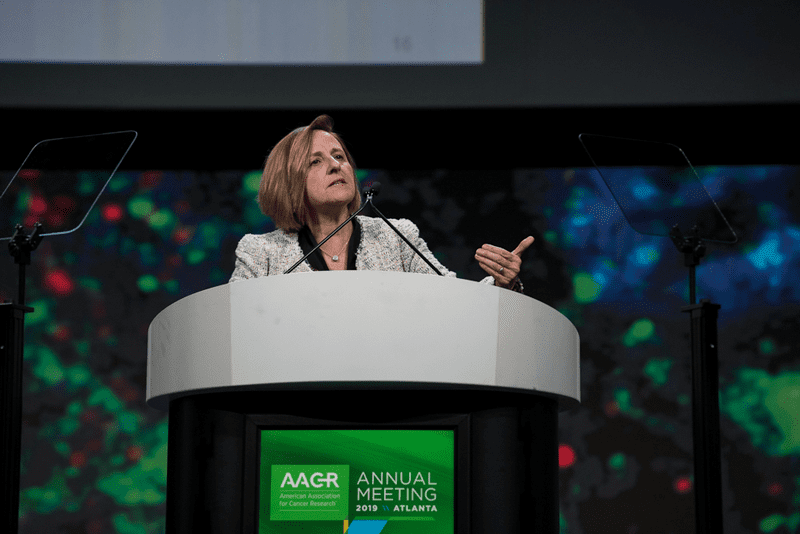
Crystal Mackall, MD, discusses improved CAR T cell strategies.
With respect to overcoming CAR T cell exhaustion, Mackall developed CAR T cells that exhibited constant signaling activity and, as a result, became consistently exhausted. Then, after causing these CAR T cells to overexpress the protein c-Jun, she observed decreased expression of inhibitory receptors and increased production of interleukin-2 (IL-2), an important stimulator of T cell proliferation. More importantly, she showed that c-Jun-overexpression enhanced the activity and persistence of CAR T cells against osteosarcoma, a type of bone cancer, as well as low-antigen density leukemia.
Turning to solid tumors, Prasad Adusumilli, MD, of Memorial Sloan Kettering Cancer Center (MSKCC), discussed work led by MSKCC’s Michel Sadelain, MD, PhD, a member of the CRI Clinical Accelerator leadership, who began this project with funding from the SU2C-CRI Immunology Dream Team. Adusumilli highlighted their phase I clinical trial that used regional delivery of mesothelin-targeting CAR T cells to treat patients with malignant pleural disease. Some of these patients were also treated with a condition regimen (cyclophosphamide) and PD-1 checkpoint immunotherapy (although not as part of this trial), and persistence of these CAR T cells was associated with tumor regression as indicated by imaging analysis. Of the eleven patients who received CAR T cells, cyclophosphamide, and PD-1 therapy, 72% had at least partial responses; there were also clinical responses observed in patients who didn’t receive PD-1 therapy. Incredibly, no treatment-related toxicities higher than grade 2 were observed, and with respect to some of the most dangerous CAR T-related side effects, there were no cases of neurotoxicity and only three cases of grade 1 cytokine release syndrome (CRS). Due to the ability to this therapy to “transform cold tumors to hot and keep them warm,” (meaning, making them more attractive to attacking immune cells) Sadelain’s team has planned a combination trial for later this year involving these mesothelin-targeting T cells plus PD-1 immunotherapy as well as another trial utilizing mesothelin-targeting CAR T cells that have been engineered to be resistant to the suppressive effects of PD-1 pathway signaling.
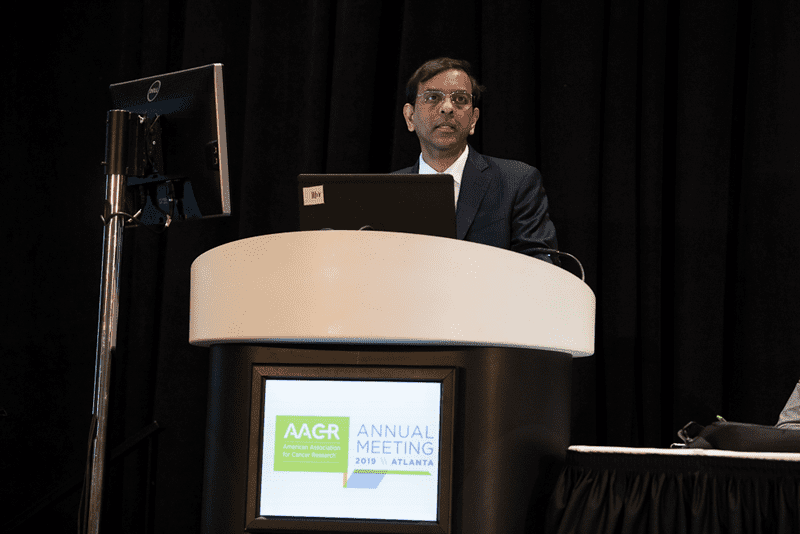
Prasad Adusumilli, MD, discusses a SU2C-CRI Immunology Dream Team project using regional delivery of mesothelin-targeting CAR T cells
Two talks featuring work from the lab of Anjana Rao, PhD, a member of the CRI Scientific Advisory Council who works at the La Jolla Institute for Allergy and Immunology, also focused on strategies to overcome the limitations of CAR T cells in solid cancers.
First, Joyce Chen, PhD, discussed work involving Hyungseok Seo, PhD, a CRI-Donald J. Gogel Postdoctoral Fellow in Rao’s lab. In this work, their team showed that both natural T cells and CAR T cells that have infiltrated tumors express several proteins from the Nr4a family as well as other inhibitory receptors that are associated with decreased anti-tumor activity. However, when they designed CAR T cells that lacked these Nr4a members, they were able to enhance the destruction of tumors in mice and increase their survival, thus highlighting Nr4a as a promising target for cancer immunotherapy.
Next, Seo gave his own talk that focused on more recent work. He pointed out that CAR T cells are often dysfunctional in solid cancers and are characterized by expression of several inhibitory checkpoint markers as well as the TOX family of transcription factors that influence several immune-related activities. To determine how TOX factors influence this dysfunction, Seo and Rao took CD19-targeting CAR T cells and deleted the genes for two TOX family members. Then they investigated their ability to eradicate CD19-expressing melanoma tumors in mice. In this as-yet-unpublished work, they found that these TOX-deficient CAR T cells were able to eliminate tumors and prolong survival in melanoma-bearing mice. Additionally, these modified CAR T cells had decreased expression of the PD-1, TIM-3, and LAG-3 checkpoints that are known to inhibit T cell activity. Overall, their findings suggest that the TOX family of transcription factors play an important role in CAR T cell dysfunction, and that they could serve as promising targets to improve the benefits of CAR T cells for patients with solid cancers.
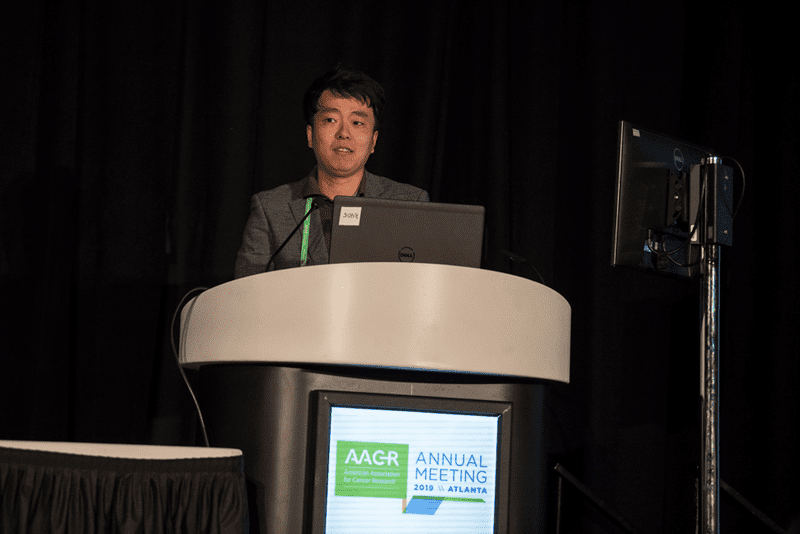
Hyungseok Seo, PhD, of La Jolla Institute, discusses CAR T cells in solid cancers
Turning to vaccines, the recipient of 2019 AACR-CRI Lloyd J. Old Award in Cancer Immunology, Cornelis J. M. Melief, M.D, PhD—who is also a member of the CRI Scientific Advisory Council and holds positions at ISA Pharmaceuticals and the Leiden University Medical Center (Netherlands)—highlighted the use of human papilloma virus (HPV)-targeting vaccines for patients with advanced cervical cancer. These vaccines, which deliver concentrated doses of HPV-derived antigens to dendritic cells, are made of synthetic long peptides (SLPs) and are capable of inducing strong and sustained killer T cells responses against HPV-infected cancer cells. Whereas this approach previously provided benefits for patients with premalignant vulvar lesions, by itself it wasn’t able to stimulate robust immune responses in patients with advanced cervical cancer, due to immunosuppression maintained by myeloid cells. This led Melief and his team to combine the SLP vaccine approach with chemotherapy. After demonstrating the benefits of this combination in mice, it was used in a pilot trial involving patients with recurrent or metastatic cervical cancer. When administered after chemotherapy, which was able to decrease the numbers of immunosuppressive myeloid cells, the vaccine induced strong T cell responses against the target HPV antigens.
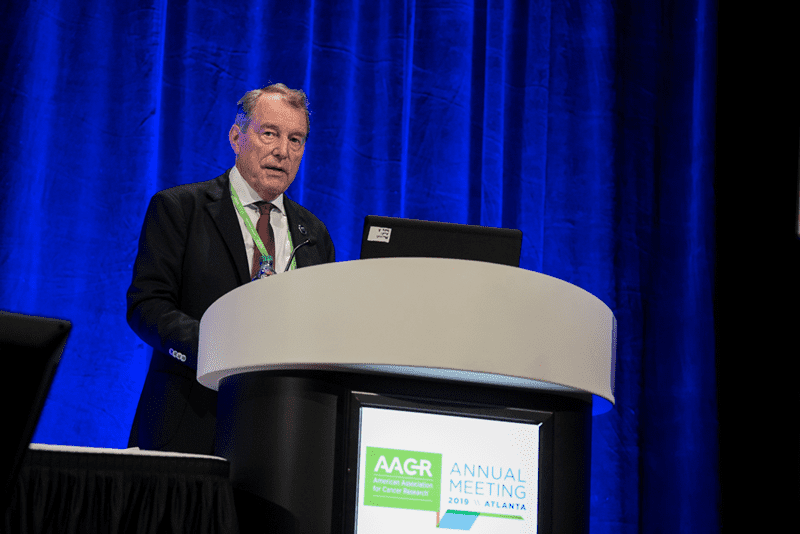
Cornelis J. M. Melief, M.D, PhD, highlighted the use of HPV-targeting vaccines.
Finally, Melief unveiled as-yet-unpublished results from their latest phase 1/2 trial evaluating this approach, demonstrating that this chemotherapy-vaccine combination showed promising early activity in patients with advanced cervical cancer. Melief’s team also uncovered several interesting insights involving associations between various immune cell populations and how they correlated with patient survival. In closing, Melief pointed to another study that combined this HPV-targeting vaccine with PD-1 checkpoint immunotherapy in patients with HPV-positive head and neck cancer, with encouraging results.
Another vaccine was highlighted by Siwen Hu-Lieskovan, MD, PhD, of the University of California, Los Angeles (UCLA), in work done in collaboration with Dana-Farber Cancer Institute’s Patrick Ott, MD, who is involved in a CRI-funded combination trial. Hu-Lieskovan discussed results from a phase I trial using the NEO-PV-01 vaccine—which is designed to target up to 20 individual proteins per patient—to treat several types of advanced cancer. In ten melanoma patients, they observed T cell responses—associated with both CD4+ helper and CD8+ killer T cells—against 56% of the protein targets vaccinated against. These responses were also durable in the patients who reached the one year follow-up mark, and most of these responses appeared to be polyfunctional, tumor-killing, and associated with memory and effector memory T cells. Additionally, these immune responses were found to have “spread” to other neoantigens expressed by the cancer cells that weren’t included in the vaccines.
Lastly, Tamara Ouspenskaia, PhD, highlighted a new way to potentially identify cancer neoantigens that could be targeted with vaccines, in work involving current CRI-Hearst Foundations Postdoctoral Fellow Susan Klaeger, PhD, and former CRI CLIP Investigator Nir Hacohen, PhD, both colleagues of Ouspenskaia’s at the Broad Institute of MIT and Harvard. Most current genome sequencing methods only cover a set of pre-determined or “annotated” genes which are thought to be the predominant genes that are expressed and turned into proteins. This is usually sufficient for heavily-mutated cancers like melanoma; however, these annotated genes only make up 1-2% of our entire genome, and as a result, don’t work particularly well for cancers with low numbers of mutations, like blood cancers. To address this gap, the approach taken by Ouspenskaia, Hacohen, and Klaeger uses a process called Ribo-seq that looks at intracellular complexes known as ribosomes, organelles which produce all the proteins in our cells. Interestingly, by looking at patient-matched samples of healthy cells and a variety of cancer cells, they found that proteins were produced (and displayed on cells via Major Histocompatibility Complex) from thousands of regions in the genome that aren’t typically though to be expressed and turned into proteins. Furthermore, the proteins encoded in these regions—known as novel, unannotated open-reading frames, or nuORFs—were over-represented compared to the whole proteome. This startling revelation provides a good example of just how much remains to be known regarding the incredibly complex biology of our cells, but also provides a promising foundation when it comes to improving care in the clinic. With this Ribo-seq method, doctors may not only be able to expand the potential repertoire of neoantigens that could be targeted with cancer vaccines, but also help them prioritize which neoantigens might be the best candidates to include in vaccines to improve patient survival.
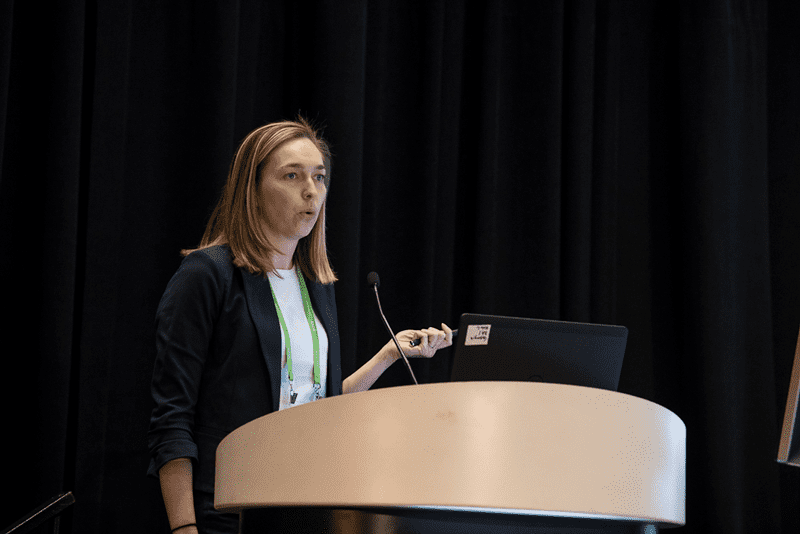
Tamara Ouspenskaia, PhD, highlights a new way to potentially identify cancer neoantigens.
That’s it for Day 3 from AACR19! Check back on our blog tomorrow for our recap of the Day 4 here in Atlanta!

